Exploring Voice and Responsibility through Literature
by Kathryn Tompkins, Fourth Grade, Van Horne Elementary School
As a classroom teacher, I occasionally encounter students who genuinely want to save the world, care deeply about others, and know the injustices that occur around the world. I say occasionally because most children know only what goes on in their immediate lives and community. The adults in their lives, including teachers, have frequently shielded them from knowledge about the difficult problems that people face in many parts of the world and the multiple views that exist on these issues. At our school, we believe that children need to gain perspectives on these issues instead of protection from the realities of their world. As part of our ongoing inquiries into global issues through literature, we want to engage students in thoughtfully considering difficult political and social issues. We know they need knowledge and understanding about these issues in order to develop their own opinions and ideas, but they also need to go beyond themselves to recognize and consider other perspectives and possibilities.
I want my classroom to reflect Rosenblatt’s (1938) concept of a democracy as a social context in which personal voice and group responsibility are balanced, so that students have conviction and enthusiasm about their own ideas along with an open mind to others’ points of views and needs. Rosenblatt argues that dialogue about literature can encourage children to open their minds to alternative perspectives and ways of thinking about the world. I want to engage my students in dialogue around literature that helps them look beyond themselves and encourages them to recognize the needs of others.
The teachers in our school decided to focus on human rights issues as part of a school-wide inquiry on global perspectives. We knew we needed to first look at rights in ways that made sense to students in their lives before moving to a broader view of rights as global issues. Since “it’s not fair” is a complaint that many children voice, we decided to begin the spring semester by asking students to name issues that they face in school and feel are unfair. Most of my students talked about not being able to choose who they sat by in the classroom or at lunch, not being able to play on all of the areas on the playground, and having to pay the consequences for the actions of a few. They had difficulty thinking beyond themselves. Their discussions about unfairness and rights were focused on themselves and they didn’t seem to see a bigger picture. I knew that we had to find a way to challenge them to think more unselfishly about the greater good, not just what would personally benefit each of them.
In our discussions about what determines if something is unfair, students argued that unfair events keep you from getting what you want and include discrimination based on age, gender, and whether someone likes you or labels you as different. They said that unfair occurrences can keep you from getting what you need, and sometimes others are allowed to do what you are being prevented from doing. The students believed that anything they saw as unfair was an indication that their rights were being violated.
Students webbed their thinking about human rights, which included the right to play, civil rights (the kids defined this as equal rights), adults and children not having the same rights (adults can drive), no one having the right to make fun of anyone else, and the right to be different and to make choices. As the students discussed their rights within the school, they often seemed to confuse rights with privileges. One piece of literature which challenged this view was For Every Child (2001), a book based on the UNICEF document on the rights of children. My students realized that they had not considered basic needs, such as food, water, clothes and somewhere to live, or the need to feel safe and cared for as human rights.
As we continued our human rights inquiry, the teachers at our school carefully chose literature that would challenge students to think beyond themselves. We believed that these books needed to offer more than information about particular global issues–they had to present characters that the students could care about to engage them in working towards actions to benefit others, not just themselves. Wade (2007) argues that “Caring for others leads naturally to working for others’ rights and well-being” (p. 7), and we saw literature as a strategy for taking students beyond information to empathy.
One book that was particularly effective in engaging students was a picture book about child labor in which the characters were their age. The Carpet Boy’s Gift (Shea, 2003) tells the story of a young boy who is forced to work from sun up to sun down making carpets to pay off his family’s debt. This story mentions Iqbal Masih, a real boy who was sold into child labor in Pakistan, but who escaped and worked with an organization to free child laborers until he was shot and killed at just twelve years old. The first reactions from students were shock at the way child workers were punished for making mistakes. If they fell asleep while working or if they made a mistake on a line from a carpet they were fined and had to work longer to pay off their debts. My students really wanted to know more about this issue. They couldn’t believe that such situations existed for children in the world today.
Their talk turned to dismay and condemnation that any parent would sell a child into slavery. They couldn’t comprehend that life would ever be so bad that a parent would consider selling a child to pay off debts. Danielle questioned, “If they need money to help their kids live, then why would they sell them?” Victoria thought that the parents in the story were just selfish and wanted to help themselves. The kids were quick to judge the families and didn’t consider how dire a situation would have to be to force a parent to sell a child. They were thinking beyond themselves, but they weren’t thinking about others in the bigger sense–they didn’t see the larger context of child labor and the issues that would lead to this desperate situation.
Students were confused by child slavery and wanted to know more so we decided to read the story of Iqbal (D’Adamo, 2005). This short novel is a fictional account of Iqbal’s life and the lives that he touched until his death at the age of twelve. The carpet factory where Iqbal and other children worked gave the students a sense of the life of child workers, how they are fined and punished for minor infractions so that it became impossible to ever pay off their family’s debts. Iqbal escaping and risking punishment again and again inspired the students because they saw how such a young child really did change the lives of many.
Students were particularly surprised that this story didn’t happen “a long time ago” but in the last 15 years. They didn’t want to believe that child labor still exists. Once we finished the novel, they responded through pictures and phrases. Many of the students chose to include a picture of a kite, because Iqbal saw flying a kite as a symbol of freedom. Others included the tally marks that the masters used to keep track of the children’s debts because they never seemed to get erased. Jose had his grandmother order the book so that he could read it again and share it with his family. The class seemed to genuinely connect with Iqbal and gained additional understandings that supported them in moving beyond blaming the families who had to sell their children towards condemning those who supported child labor financially and those who owned child slaves. They saw how Iqbal had worked tirelessly to inform children of the existence of a law against child labor, even though those in authority did nothing to enforce the law. He risked so much and inspired so many that he was invited to give speeches all over the world. This one child took on the huge responsibility to change the world of child labor. If he could do so much and take such huge risks, surely the students in a country like the United States could work to make a difference.
Child labor wasn’t an issue that the students had observed in their community, and we wanted to read aloud a book that would reflect an issue they had encountered first hand. We didn’t want to fall into the trap of viewing problems as existing elsewhere but not in our own community. We knew that stories about the homeless appeared regularly on the local news and that some children had seen homeless people in the city parks or in homeless shelters and food kitchens. We hoped that the character of Dorrie in The Lady in the Box (McGovern, 1997) would touch them on an intimate level. The story begins as a young boy and his sister notice that a woman sleeps in a box outside the local deli. They want to help her but know that they aren’t supposed to talk to strangers and so place food and clothes to help her keep warm next to her box. One day the owner of the deli forces Dorrie to move her box to another location where she can’t catch a warm draft. The children immediately notice how much colder she looks and take the responsibility of helping her because they fear that she will freeze to death. When their mother asks them about the missing food, they explain what they have been doing and take her to meet Dorrie. Dorrie tells the story of how she lost her job and couldn’t afford her apartment and so eventually ended up on the street. Their mother immediately goes to the deli owner and convinces him to let Dorrie move her box back by the warm draft. The children can’t stop thinking about doing more to help Dorrie so their mother takes them to a homeless shelter to work at a soup kitchen. When they see Dorrie there, the boy gives her his lucky key ring as a symbol of hope that she will soon have her own key.
This book immediately engaged the students because homelessness was “real” to them. The students blamed the deli owner and were frustrated with the way he treated Dorrie. Kai said, “He was greedy and didn’t care about her health.” They thought he should have given her a job and allowed her to live in the shop. The students seemed to take the idea of responsibility to different level, believing that the characters in the story should have taken on the responsibility of helping Dorrie. They saw Dorrie as innocent and thought that everyone else should be taking care of her. Robbie dared to challenge this idea by stating that he would feed her and help but he wouldn’t let her in the store. His statement that she might steal something because “you don’t really know how she lost all of her money” angered many students. They wanted to take action to help someone who is homeless in a similar way to the children in the story. I was concerned that they were still casting blame on others instead of coming up with ways they might personally take action to help the homelessness. They weren’t discussing plans on how to help people like Dorrie who are homeless but rather assigning blame on others.
The students completed art responses to the book using sketch to stretch to show the meaning that they took away from the book. Some students felt happy that Dorrie had people who cared about her and felt satisfied that others were taking action to help her situation. Others seemed less optimistic about Dorrie’s future and the entire issue of homelessness. They weren’t sure how to resolve either situation.
Another familiar issue for students in Tucson is immigration because our city is just one hour away from the border with Mexico and a major corridor for undocumented people who are trying to enter the United States. Many of our students have family in Mexico or travel there frequently. They hear about the problems of undocumented people through the news and family discussions and so we chose a bilingual book, Friends from the Other Side (Anzaldua, 1993) as a read aloud. Prietita is a young girl living on the U.S. side of the border who becomes friends with a little boy who is hiding from authorities with his mom. Prietita notices how the neighborhood kids tease Joaquin and decides to stand up to them. Joaquin takes Prietita home to meet his mother who tells her that they had to cross the border because she couldn’t find work to support herself and Joaquin. When the border patrol comes to the neighborhood, Prietitia hides Joaquin and his mother at the herb woman’s house. The border patrol agents question the people in the streets about “illegals” but everyone says that they haven’t seen any so the patrol moves on.
After the read aloud the students conducted mock interviews in pairs, with one being a reporter and another a character from the story. Some of the students took the perspective of Joaquin and were angry that anyone would ever be taken out of the U.S. if they didn’t want to leave, while others took the perspective of the border patrol and said that they had dangerous jobs. Students like Kai thought that “a couple of people couldn’t hurt a town.” Robbie thought that everyone should have “papers to get good jobs” and Zach worried about the city “getting overpopulated.” Alyssa felt that “the border patrol keeps us safe.” The discussion turned when Tessa said that we live in a “free country.” Her statement implied that anyone and everyone who wants to should be able to live in the U.S. and not be discriminated against. This was the first time that distinct individual voices were expressed in our discussion without moving to a group voice; students strongly expressed their different opinions on the issue of immigrants entering the U.S. without documentation. More students were voicing their thoughts and offering solutions to the problem than in our previous class discussions. Some students felt that it was okay for undocumented people to live and work in the U.S. and offered ideas of jobs and how much they should be paid. Other students wanted everyone to have documentation to live in the U.S., and several felt that the border patrol has a dangerous job to keep Americans safe. They had differing views on what rights all people have versus what rights they felt that Americans have. This discussion was the first time that students explored the tensions of individual rights and group responsibility in a thoughtful dialogue with each other. We ended the discussion by taking time for a quick write about their perspectives on this issue.
We returned to our focus on children’s rights in our school to see if students would consider those issues from both individual and group perspectives. The most significant issue for my students seemed to be that not all students have the same rules on the playground. They were finally thinking beyond themselves and wanted to work to help the entire school with what they saw as unjust issues. They thought that the rules should be the same for every student on the playground, regardless of grade level. They wanted everyone to benefit by having the same rights–all students should be able to play in all areas on the playground and everyone should be able to check out equipment to play with. I was pleased that they were thinking about how to take action but realized that they were confusing fair with equal and didn’t realize that fairness and equality do not always involve everyone being treated exactly the same.
What was most significant, however, was their sense of empowerment that their voices did matter. Wade (2007) states that, “Taking action allows students to move from a position of powerlessness to one of possibility” (p. 14), and this focus on possibility was a shift for my students. Their first step in coming up with a plan to fix the injustices occurring on the playground was to interview a playground monitor to find out the reasons behind the rules and her feelings about the rules. The monitor was very nervous and the students were careful to let her know that they were not angry with her but were trying to understand the situation from her perspective. At the end of the interview the students’ understanding seemed to be that someone (we still didn’t know who) created the rules on the playground to keep students safe. The older students at the school had more freedom because there were fewer children to watch when they were outside. Some students seemed resigned to the idea that adults make the rules to keep children safe and so we should just accept the rules, but others still wanted to have a say in those rules. They were not giving up because they felt that their actions could make a difference.
The students decided that their group action would be to take responsibility for communicating how they felt about the rules to adults in the school. They wanted class representatives from each of the intermediate grades to have meetings with the principal on a regular basis to discuss the playground rules and any changes that needed to be considered. They knew this kind of change could not occur until the fall, but they also wanted to immediately have an assembly to ask other students in the school to write down what they thought about the current school rules. This request was a significant step for them because they no longer assumed that everyone else shared their perspectives on the rules. They emailed the school principal with their proposal but there was only a week left of school and so the assembly was delayed until August. One major shift that occurred in this experience was that students did not ask adults to make the change for them or simply place blame on adults for problems. They took responsibility for challenging and working to change injustices around them.
All too often we underestimate children’s desire and ability to be involved in the decisions that affect their lives and the lives of others. The literature that we chose to share with students demonstrated that one voice, no matter how small, can make a difference in the world. Through literature, they gained new understandings about social issues and the ways in which they can take action to benefit children and adults who are in difficult situations. Their emotional connections to the characters in these stories supported them in considering perspectives beyond their own knowledge and views. The books invited them to live within the “story world” of that character for a period of time and to consider their experiences and views of particular issues. They were able to try on a new perspective and to gain a different understanding of the complexity of particular issues. Their focus on taking action within their own world of the school shifted through these experiences from a focus on individual needs and benefits to a consideration of both their individual voices and their responsibility to the greater good of others at the school. They also moved beyond either simply blaming adults or standing aside to let adults take care of problems. By questioning “what is” and imagining “What if?,” the students took a significant first step toward standing up and taking action to injustices on the world.
References
Anzaldua, G. (1993). Friends from the other side. San Francisco: Children’s Book Press.
D’Adamo, F. (2005). Iqbal. New York: Aladdin.
McGovern, A. (1997). The lady in the box. New York: Turtle Books.
UNICEF (2001). For every child. New York: Dial.
Rosenblatt, L. (1938). Literature as exploration. Chicago: Modern Language Association.
Shea, P.D. (2003). The carpet boy’s gift. Gardiner, ME: Tilbury House.
Wade, R.C. (2007). Social studies for social injustice. New York: Teachers College

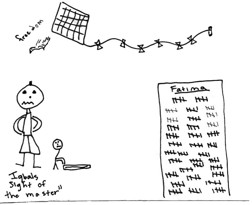
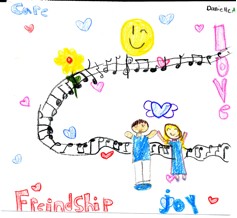
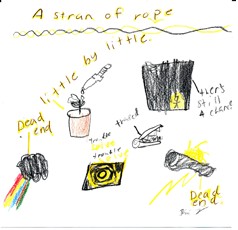
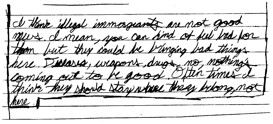
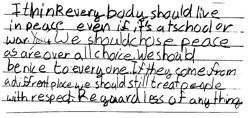
One thought on “WOW Stories: Connections from the Classroom”